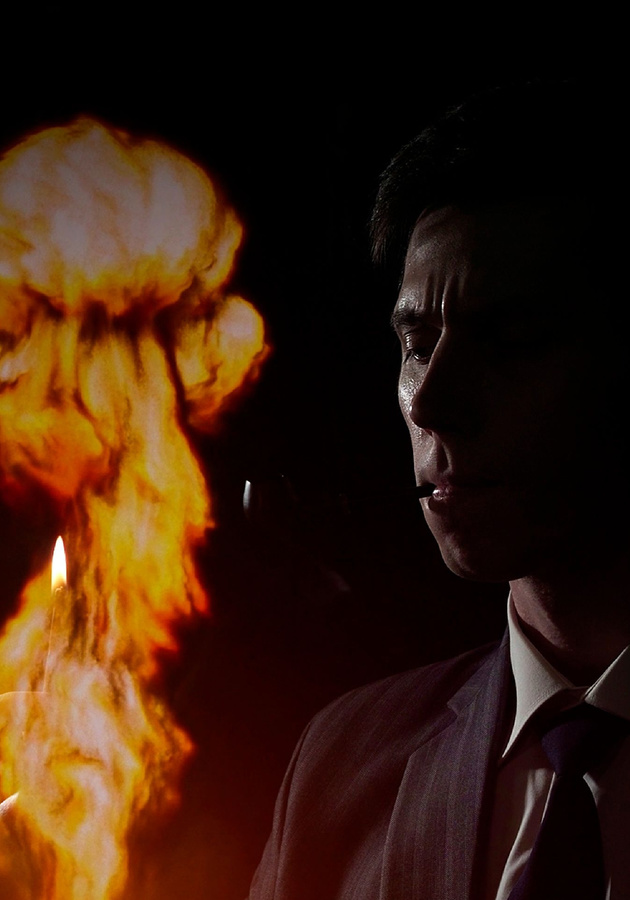Garry Kasparov is widely considered the greatest chess player of all time. From 1984 until his retirement in 2005, he was ranked No. 1 in the world for 255 months overall for his career. To this day, he still holds the record for the most consecutive professional tournament victories (15) and Chess Oscars (11). After becoming the youngest World Chess Champion ever in 1985, he defended his title on six different occasions, and kept winning tournaments until the very last days of his career. In fact, when he retired in 2005, he was still the world’s highest-rated chess player.
However, for people primarily interested in technology, Kasparov is arguably much better known as the first world chess champion to be defeated by a computer. In 1997, in a now famous six-game match with the IBM supercomputer Deep Blue, Kasparov lost 3½-2½. The event marked the dawn of a new era in artificial intelligence, bright with possibility and riddled with doubts and fear. In “Deep Thinking,” Kasparov tells his side of the story – and investigates the present and future of AI. So, get ready for an exploration of two worlds: those of chess and chess machines.
The brain game
Chess is so old that it is somewhat difficult to understand its origins. Most probably it evolved from an older Indian game called chaturanga sometime before the sixth century. Then it moved to Persia and the Muslim world, from where it was transported into southern Europe via Moorish Spain. “By the time of the late Middle Ages,” writes Kasparov, chess “was a standard presence in the courts of Europe and appears regularly in manuscripts from the period.” A curiosity for the curious: the third book ever printed in English was “The Game and Playe of the Chesse” by William Caxton, the very man who introduced the printing press into England.
At the beginning of the 18th century, chess was already considered “a touchstone of intellect,” as Germany’s greatest writer Johann Wolfgang von Goethe once remarked. The ability to play chess well was taken as synonymous with the ability to think well, and the leading chess players in most Western European countries were considered nothing short of geniuses. Case in point, after the great French player François-André Danican Philidor won two games simultaneously while blindfolded in 1782, he was acclaimed by the newspapers of the day as “an intellect without parallel” and “a phenomenon [that] should be hoarded among the best samples of human memory.” However, there are tens of thousands of competent chess players around the world nowadays that can easily win two games without sight of the board. In December 2016, over the course of 23 hours, 28-year-old grandmaster Timur Gareyev played 48 such games, all the while riding an exercise bike, and he won 80% of them. Even Philidor would have been left speechless.
Kasparov is not as easily amazed. He is adamant that this is a skill that can be learned – just like the game of chess itself. And he is not particularly pleased with the fact that great chess players are considered geniuses even in the 21st century. Just browse around the net and you’ll find Kasparov’s name on many lists of the “highest IQs in history,” there between Einstein and Hawking. The man himself laughs off such suggestions, not only because he has taken zero IQ tests in his life, but also because he knows that there is no real connection between chess skill and general intelligence. “There is no more truth to the thought that all chess players are geniuses than in saying that all geniuses play chess,” he writes. “In fact, one of the things that makes chess so interesting is that it’s still unclear exactly what separates good chess players from great ones.”
The cultural prominence of chess
There are two reasons why people mistake chess skill for splendid intellect, particularly in the United States. The first one is lack of familiarity with the game. As Kasparov notes, “relatively few Westerners play chess at all and fewer play to a level beyond knowing the rules.” Hence, chess seems much more mystical than, say, poker and backgammon where chance also plays some role. There is no place for luck in chess: it is “a 100% information game: both sides know everything about the position all the time. There are no excuses in chess, no guesses, nothing out of players’ control.”
The second reason why chess is so often misunderstood is its almost mythical status in pop culture. Ever since the beginnings of Hollywood, chess has been used in thousands of movie scenes as “an indicator of brilliance and strategy.” In one form or another, you’ll find chess references in “James Bond” and “X-Men,” as well as in “Harry Potter,” “Twilight” and “Star Wars.” Moreover, you’ll find chess imagery in ads for banks and insurance companies, as well as in Honda and BMW commercials. “When you consider that only an estimated 15% of the US population plays chess,” Kasparov grins, “its cultural prominence is extraordinary.”
Another thing that’s most extraordinary is the prevailing negative stereotype of chess players as “socially stunted” human beings. The idea that chess players are quiet, quirky people incapable of normal communication is so widely accepted in the United States that, from “The Big Bang Theory” to “The Queen’s Gambit,” a lack of emotional intelligence and capacity for normal life is almost routinely accompanied by strong chess skills and keen interest in the game. The hackneyed notion that with genius comes madness has hit chess players particularly hard. A few prominent real-world cases have contributed greatly to the longevity of this stereotype.
The mad chess genius
Louisiana chess prodigy Paul Morphy is sometimes considered the first American world champion in any discipline, albeit unofficially. In 1858, at the age of just 21, he decisively defeated German master Adolf Anderssen, regarded as the world’s leading chess player at the time. To everyone’s surprise, just a year later, Morphy abruptly retired from chess to begin an unsuccessful law career. Soon after, he started suffering from mental breakdowns. Many attributed them, without any evidence or effort to investigate their origins, to “the strain of his chess exploits.” Simply put, Morphy was considered too smart to be sane, and chess too complicated to not drive him off the edge.
Dubbed “The Pride and Sorrow of Chess,” Morphy is still casually described as “the archetypal chess genius”: immensely clever and creative, but also eccentric and erratic to a fault. The very same description can be applied to his much more famous successor, Bobby Fischer, the first non-Soviet world champion and the only American to officially hold that title as of 2021. A whole century after Morphy, in the midst of the Cold War, Fischer snatched the world championship title from Boris Spassky before millions of captivated observers from around the globe. For many of them, the match had great symbolic importance, as it had pitted the brilliant, fierce, individualistic and utterly unconventional American Fischer against the foremost product of the mighty, well-oiled, but ultimately cold and soulless Soviet chess machinery.
Fischer’s victory made chess popular in the West. It also made the Soviets quite mad. Before Fischer, the USSR had completely dominated the world of chess for decades, winning all but one of the 19 Chess Olympiads in which it had participated. Not only were all undisputed post-war chess champions Soviets, but their challengers had been Soviets as well. Unsurprisingly, Fischer’s next challenger was also supposed to be a Soviet – a young, quiet and immensely promising positional player by the name of Anatoly Karpov.
However, Fischer never gave Karpov the chance for a championship contest. Just like Morphy before him, he couldn’t even bring himself to play chess after winning the world title. He grew erratic and reclusive and vociferously anti-Semitic and anti-American. In the eyes of many, he became the poster boy for “the mad chess genius,” a species with a long history in literature and cinema. In the eyes of Kasparov, however, he should be remembered as something else: an ideal challenger and a disastrous champion. “It was not chess that drove Fischer mad, if indeed he ever was mad,” he writes. “Fischer’s tragic downfall wasn’t what happens when someone plays chess; it’s what happens when a fragile mind leaves his life’s work behind.”
Two types of thinking and endless combinations
According to a famous legend related to the origins of chess, when the inventor of the game presented it to the Indian emperor for the first time, the spellbound ruler offered him any reward that he wanted. The inventor asked that a single grain of rice be placed on the first square of the chessboard, two grains on the second square, four on the third and so on for all the 64 squares, with each subsequent square having double the number of grains as the square before. The emperor, perplexed that the inventor had asked such a small price for such a wonderful discovery, immediately agreed. He realized his grave mistake soon after. By the time his servants got to the 20th square of the chessboard, it was already obvious to everybody that the amount of rice the emperor would need to pay his debt to the inventor was more than the amount of rice he had ever possessed.
Indeed, one would need 18.4 quintillion grains of rice to cover a chessboard following this rule – almost 1,000 times the entire estimated yearly global production of rice! Hence, this story is not only a good demonstration of exponential growth, but also an even better illustration of the immense number of possible combinations in chess. In 1949, American mathematician Claude Shannon did the math and in his seminal paper “Programming a Computer for Playing Chess” estimated that there are approximately 10120 variations from the starting position in chess. That’s more – far more, in fact – than the number of atoms in the known, observable universe!
The number isn’t exact, but precision wasn’t Shannon’s intention in the first place. He just wanted to demonstrate the impracticality of solving chess by brute force or, what he termed, Type A thinking. Type A thinking, explains Kasparov, is “an exhaustive search method that examines every possible move and variation, deeper and deeper with each pass.” On the other hand, Type B thinking assumes “a relatively efficient algorithm that works more like the way a human player thinks by focusing only on a few good moves and looking deeply at those instead of checking everything.” Back in 1949, computers were just too slow to calculate the value of all possible moves from a given position and choose the most logical one. So, Shannon put his hopes in the smarter, but much more difficult to devise and develop, Type B strategy. Little could he have guessed that in just a few decades, a brute force computer would be able to beat the world champion in a game of chess.
The prehistory of chess machines
Due to the long-standing reputation of chess as “a unique nexus of the human intellect,” chess playing machines were dreamt of long before it was possible to make them. Already in 1770, Hungarian inventor Wolfgang von Kempelen presented Empress Maria Theresa of Austria with a mechanical chess playing automaton called the Turk. For the next 84 years, the Turk toured the world to great acclaim, winning numerous games against strong opponents and famous chess aficionados such as Napoleon Bonaparte and Benjamin Franklin. The Turk was eventually bought by Edgar Allan Poe’s personal physician, John Kearsley Mitchell, who donated it to the Baltimore Peale Museum. It was there that a fire cut short the career of the Mechanical Turk.
The whole thing was, of course, a hoax: there was a human chess master hidden inside the cabinet-like box on top of which the chessboard was placed. The chess master could puppeteer the Turk and move the pieces thanks to an ingenious series of levers. It would take humans an entire century after the destruction of the Turk to develop a real chess program. Interestingly, this program was developed before the computer was. Its developer was none other than British genius Alan Turing, the man who cracked the Nazi Enigma code. In 1952, inspired by Claude Shannon’s essay, he processed a chess algorithm on slips of paper, playing the role of CPU himself. For all intents and purposes, Turing’s “paper machine” should be remembered as the first chess program capable of playing a competent, full game of chess against human opposition.
Four years later, in the nuclear laboratory of Los Alamos, scientists took the theories of Turing and Shannon and turned them into an actual chess playing machine, MANIAC 1. One of the first computers ever made, MANIAC 1 had a limited processing capacity so it had to use a reduced six-by-six board and learn to play without the bishops. It lost a game against a strong human opponent (despite the human playing without a queen), but just after, it beat a young volunteer who had just learned the game. Though the event didn’t make any headlines, it was “the first time a human had lost to a computer in a game of intellectual skill.”
Rise of the chess machines
In 1956, the same year that MANIAC 1 was made, AI pioneer John McCarthy invented “alpha-beta pruning,” a search algorithm that allowed programs “to rapidly prune out weak moves and thus see further ahead, faster.” Just a year later, a group of researchers at Carnegie Mellon University, led by visionaries Allen Newell and Herbert Simon, proclaimed that they could use this alpha-beta algorithm to build a Type B-style chess machine capable of defeating the world chess champion within the following decade. That didn’t happen. In fact, in the eyes of many, such a machine seemed just as unimaginable in 1968 as it did in 1958. Even so in 1968, McCarthy, the inventor of alpha-beta pruning, was optimistic enough to make a bet with Scottish International Master David Levy that a chess playing computer would beat Levy sometime during the next decade.
To the surprise of many, by 1978, chess playing programs were actually good enough to compete. Just a year before the deadline set by McCarthy, a program developed by Northwestern University simply called Chess finished first in an open tournament in Minnesota. It was a version of this program, Chess 4.7, that challenged Levy to a six-game match in September 1978. In the end, Levy won the match (and, hence, the bet with McCarthy) quite comfortably. However, Chess 4.7 did manage to score a draw in game two and, strikingly, a win in game four – the first time a computer had defeated a human master in chess.
At the time, Kasparov estimates, chess machines could already play at an expert level, that is, the level of the top 5% of human chess players. But they were still no match for grandmasters such as him. That all changed over the following decade, due to “the relentlessness of Moore’s law.” Simply put, rapid leaps in computing power made possible a switch from Type B to Type A programming strategies: in the 1980s, computers needed just seconds to process tens of thousands of combinations – not weeks. Therefore, in 1986, Levy could pose the question “When Will Brute Force Programs Beat Kasparov?” in the title of an article published by the International Computer Games Association. Just two years later, a Carnegie Mellon computer named Deep Thought (after the one in Douglas Adams’ “Hitchhiker’s Guide to the Galaxy”) scored the first machine tournament win against a grandmaster, the “Great Dane” Bent Larsen. It was time for Kasparov to enter the arena.
Kasparov vs. Deep Blue: setting the scene
Larsen was once a serious candidate for the world chess championship, but at the end of the 1980s, he was no Kasparov. Nobody was back then – not even computers. In October of 1989, Kasparov played a two-game exhibition match against an updated version of Deep Thought in New York City. Even though Deep Thought was capable of searching more than two million positions per second, Kasparov dealt with it fairly easily.
A few months later, the programmers behind Deep Thought graduated from Carnegie Mellon and joined IBM Research. There, they renamed their chess playing computer Deep Blue and spent the next seven years improving its algorithms and feeding it more and more raw data. In February of 1996, they challenged Kasparov once again. In a match sponsored by the Association for Computing Machinery, Kasparov emerged victorious once again by a score of 4-2. Nevertheless, Deep Blue won the first game, thus becoming the first machine to win a chess game against a reigning world champion under regular controls.
The publicity surrounding this victory took Lou Gerstner – then CEO of the ailing IBM – completely by surprise. Not the least because the performance of Deep Blue had boosted the company’s share price, a rematch was immediately agreed. With the company’s reputation at stake (as well as $1 million of its money offered to the winner as a reward), IBM put all of its technical and administrative resources into ensuring that Deep Blue would emerge triumphant in the May 1997 rematch.
In other words, they didn’t just heavily upgrade the computer’s hardware as was naturally expected – they also fine-tuned its software to suit Kasparov’s style better. And they did so covertly, with the help of a group of chess grandmasters. Furthermore, IBM refused to provide a private “team room” for Kasparov and his seconds for consultations during the games. Finally, they declined Kasparov’s request for the training games Deep Blue had played with several grandmasters in preparation for the main event, with the explanation that such games had never happened. But Kasparov knew they had. So, he also knew this wasn’t a friendly game or a scientific experiment anymore. It was a PR event.
Kasparov vs. Deep Blue: the 1997 match
Controversies aside, the 1997 rematch between Kasparov and Deep Blue was a cliffhanger for the ages. The Russian grandmaster won the first game with white and some panache, but then infamously resigned the second in a pretty much drawn position. True, Deep Blue was about to go material up by taking Kasparov’s bishop, but the computer had left its king pretty much undefended, giving Kasparov the chance to force a draw by perpetual check. Too focused to win, the Russian grandmaster had forgotten that not losing is just as good when you’re already ahead.
Visibly shaken, Kasparov accused IBM of cheating after the game, alleging that a grandmaster must have helped Deep Blue with one or two key moves. IBM, of course, vehemently denied the accusations, but that only exacerbated Kasparov’s anger and frustration at the company. Even so, he did manage to draw the following three games with Deep Blue. In the first of the three, he played an esoteric, irregular opening to confuse the computer. In the second, he got into time trouble late in the game and played a few suboptimal moves that may have cost him the victory. In the penultimate game of the six, only Deep Blue’s inhumanly brilliant endgame prevented Kasparov from winning and entering the final match with an advantage.
This way, in a true thriller style, it all came down to the last game of the six. Kasparov once again employed a dubious anti-computer move at the start of the game to get Deep Blue out of its comfort zone. This time, the tactic backfired: to Kasparov’s surprise, the computer knew the refutation and played it by the book. So, after sacrificing a knight, Deep Blue completely wrecked Kasparov’s defense, forcing him to resign the match in less than 20 moves. The unthinkable happened on May 11, 1997: the world champion in chess was defeated by a computer algorithm. Always the bitter loser, Kasparov refused to accept the defeat and demanded a rematch under more transparent rules. IBM declined and instead immediately retired Deep Blue. The computer never competed again.
Humans and machines
Deep Blue’s victory over Kasparov in 1997 was immediately dubbed a milestone in the history of artificial intelligence. It marked the first major public triumph of programmed intelligence over evolved, biological intelligence, by all accounts ushering humanity into a new era. However, with hindsight, the headlines of 1997 seem greatly exaggerated. With help or without it, Deep Blue never actually played at Kasparov’s level in 1997; it was Kasparov who played slightly worse than he should have, either due to IBM’s machinations or due to the practical impossibility to properly prepare for his opponent.
There is also another factor we must consider: psychology. You see, Kasparov never really recovered psychologically after missing a relatively easy draw by repetition in the second game. But that’s how we are, humans: we get disappointed, we get stuck in the past, we get overwhelmed by regrets. In each of these situations, we perform worse than our skills can vouch for us. For this reason, when humans play chess against other humans, they don’t necessarily care about making the best move in a given situation, but about making the move that would make their current opponent as uncomfortable as possible. You can’t play that way against a computer. Computers are emotionless and, unlike humans, they always play to the best of their potential.
Kasparov was pretty disappointed after his defeat. Not only because he had lost, but also because he feared that chess was just the first domino to fall before AI took over the world. But then, seeing how new generations of players started using engines to get better at chess, he realized that machines, rather than replacing us, can actually augment our capabilities. “Our technology can make us more human by freeing us to be more creative,” he writes. “Machines cannot dream, not even in sleep mode. Humans can, and we will need our intelligent machines in order to turn our grandest dreams into reality. If we stop dreaming big dreams, if we stop looking for a greater purpose, then we may as well be machines ourselves.”
Final notes
Intelligent, absorbing and provocative, “Deep Thinking” by Garry Kasparov is simultaneously a firsthand account of a watershed moment in the history of chess and artificial intelligence and an optimistic exploration of the future of human-machine interactions.
To quote Kirkus Reviews, “thoughtful reading for anyone interested in human and machine cognition and a must for chess fans.”
12min tip
“Romanticizing the loss of jobs to technology is little better than complaining that antibiotics put too many grave diggers out of work,” Garry Kasparov memorably remarks. So, instead of lamenting their arrival, try to understand machines and see if they can augment your experiences and help you become a better human being. Because inevitably they will come. Better be prepared when they do.





























